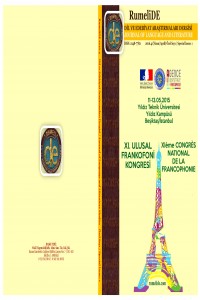Öz
Yazın dünyasının
önemli isimlerinin farklı coğrafyalara yaptıkları seyahatlerin ardından kaleme
aldıkları metinler, bugün, sadece yazın dünyası için değil, aynı zamanda
sosyologlar, antropologlar, tarihçiler, siyaset bilimciler ve kültür
araştırmacıları için de önemli başvuru kaynaklarını oluşturmaktadır. Yazar ve
sanatçıların diğerlerinden farklı bir duyarlılık ve bakış açısıyla kaleme
aldıkları gözlemleri bizlere görünenin altında gizlenen gerçeklikleri ve
işleyişlerini gösterirler. Sanatçının imgelemi, bazen gerçekleri gizlese de,
soyutlayıp bağlamından koparıyor görünse de, diğer birçok bilim dalının
söyleyemediğini ya açıkça dile getirir ya da telkin eder. Bu açıdan bu metinler
büyük önem arz etmektedirler. 1986 yılında, Gorbaçov yönetimindeki dönemin Sovyetler
Birliği, Kırgızistan’ın Bişkek/Frunze ilinde, Cengiz Aytmatov’un öncülüğünde
gerçekleştirilen Issık-Göl Forumu’na aralarında Claude Simon, Arthur Miller,
Peter Ustinov, Federico Major, Yaşar Kemal ve Zülfü Livaneli gibi önemli isimlerin
bulunduğu 15 sanatçı ve düşünürü davet eder. Çağdaş Fransız yazınının tanınmış
isimlerinden, Nobel ödüllü Claude Simon bu gezi boyunca aldığı notları
Fransa’ya dönüşünden sonra düzenleyerek L’Invitation/Davet ismiyle yayınlar. Simon’un yapıtı,
‘Demir Perde’nin ardındaki dünyayı alaycı ve usta bir anlatımla betimlemekte,
bugün bile ‘kapalı kutu’ olarak gizemini koruyan Sovyet rejiminin ve bu
coğrafyadaki yaşam biçiminin çarpıcı görünümlerini sunmaktadır. Bu çalışmada, metnin
anlatı yapısı analiz edilerek, Batılı ve özgür bir aydın olan Claude Simon’un
gözünden aktarılan bu yolculuğa ve Gorbaçov yönetimindeki Sovyetler Birliğine
ait fragmanlar örneklerle gösterilmeye çalışılmıştır.
Anahtar Kelimeler
Claude Simon L’Invitation gezi edebiyatı çağdaş Fransız romanı
Kaynakça
- Aliette, A. (1990). Le passé récomposé. Magazine Littéraire. n. 275. 96-103.
- Alphan, M. (1988a). Simon l’invité. Libération. 6 Janvier.
- Alphan, M. (1988b). J’ai deux souvenirs d’intense fatique: la guerre et le Nobel. Libération. 6 Janvier.
- Aytmatov, C. (2013). Beyaz Gemi. çev. Refik Özdek. 35. Bs. İstanbul: Ötüken.
- Bonhomme, B. (2005). Claude Simon, L’Ecriture
- Cinématographique. Paris: Editions L’Harmattan.
- Dällenbach, L. (1988). Claude Simon. Paris: Editions du Seuil.
- Elaho, R.- O. (2006). Claude Simon ile söyleşi. çev. Ahmet Gögercin. Damar. Kasım. s. 188. 8-13.
- Jean, G. (1971). Le Roman. Paris: Editions du Seuil.
- Knupp, B.-L. (1969). Interview avec Claude Simon. Kentucky Romance Quarterl. n. 16. 179-190.
- Livaneli, Z. (2003). Gorbaçov’la Devrim Üzerine Konuşmalar. İstanbul: Remzi Kitabevi.
- Piaget, J. (1985). Claude Simon Prix Nobel de Littérature. Le Monde. 18 Octobre.
- Ricardou, J. (1986). sous la direction de. Lire Claude Simon. Paris: Les Impressions Nouvelles.
- Simon, Cl. (1969). La Bataille de Pharsale. Paris: Les Editions de Minuit.
- Simon, Cl. (1986). Discours de Stockholm. Paris: Les Editions de Minuit.
- Simon, Cl. (1987). L’Invitation. Paris: Les Editions de Minuit.
- Sykes, S. (1979). Les Romans de Claude Simon. Paris: Les Editions de Minuit.
Öz
Texts written by
significant names of the literary world after their travels to various
geographies are regarded as important sources for not only the world of literature,
but also sociologists, anthropologists, historians, political scientists and
culture researchers today. Observations of writers and artists, written with a
different sensibility and perspective from others’, reveal realities hidden
under observations and their working processes. Although an artist’s
imagination sometimes seems to hide the reality and isolate it from its
context, it either clearly gives utterance to what many other scientific areas
cannot articulate, or it inculcates. In this respect, those texts are of great
importance. The Soviet Union under the regimen of Gorbachev invited fifteen artists
and philosophers including significant names such as Claude Simon, Arthur
Miller, Peter Ustinov, Federico Major, Yaşar Kemal and Zülfü Livaneli to
Issyk-Kul Forum, led by Chinghiz Aitmatov, and held in Bishkek, Kirghizstan in
1986. Nobel laureate Claude Simon, one of the most famous names of contemporary
French literature, edited and published his travel notes under the title L’Invitation/The Invitation upon his return to France. Simon’s work depicts the
world behind the ‘Iron Curtain’ with a cynical and ingenious expression, and it
presents pictures of the Soviet regime maintaining its enigma as a ‘closed box’
even today, as well as offering impressive aspects of life style in that
geography. The aim of this study is to expose this travel and the Soviet Union
fragments under the regimen of Gorbachev from the French viewpoint with
examples from the above-mentioned text, from Claude Simon’s perspective as a
Western and independent luminary, by researching the narrative structure of the
text.
Anahtar Kelimeler
Claude Simon Invitation travel literature contemporary French novel
Kaynakça
- Aliette, A. (1990). Le passé récomposé. Magazine Littéraire. n. 275. 96-103.
- Alphan, M. (1988a). Simon l’invité. Libération. 6 Janvier.
- Alphan, M. (1988b). J’ai deux souvenirs d’intense fatique: la guerre et le Nobel. Libération. 6 Janvier.
- Aytmatov, C. (2013). Beyaz Gemi. çev. Refik Özdek. 35. Bs. İstanbul: Ötüken.
- Bonhomme, B. (2005). Claude Simon, L’Ecriture
- Cinématographique. Paris: Editions L’Harmattan.
- Dällenbach, L. (1988). Claude Simon. Paris: Editions du Seuil.
- Elaho, R.- O. (2006). Claude Simon ile söyleşi. çev. Ahmet Gögercin. Damar. Kasım. s. 188. 8-13.
- Jean, G. (1971). Le Roman. Paris: Editions du Seuil.
- Knupp, B.-L. (1969). Interview avec Claude Simon. Kentucky Romance Quarterl. n. 16. 179-190.
- Livaneli, Z. (2003). Gorbaçov’la Devrim Üzerine Konuşmalar. İstanbul: Remzi Kitabevi.
- Piaget, J. (1985). Claude Simon Prix Nobel de Littérature. Le Monde. 18 Octobre.
- Ricardou, J. (1986). sous la direction de. Lire Claude Simon. Paris: Les Impressions Nouvelles.
- Simon, Cl. (1969). La Bataille de Pharsale. Paris: Les Editions de Minuit.
- Simon, Cl. (1986). Discours de Stockholm. Paris: Les Editions de Minuit.
- Simon, Cl. (1987). L’Invitation. Paris: Les Editions de Minuit.
- Sykes, S. (1979). Les Romans de Claude Simon. Paris: Les Editions de Minuit.
Ayrıntılar
| Bölüm | Türk dili, kültürü ve edebiyatı |
|---|---|
| Yazarlar | |
| Yayımlanma Tarihi | 21 Nisan 2016 |
| Yayımlandığı Sayı | Yıl 2016 Sayı: 4 |

